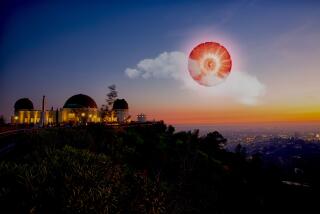Images of a Saturn Moon Hint at Life-Friendly Water
Images from NASA’s Cassini spacecraft show that Saturn’s moon Enceladus may have liquid water erupting from giant Yellowstone-like geysers, raising the tantalizing possibility that the icy moon could support some form of life, scientists said Thursday.
“We realize that this is a radical conclusion,” said Carolyn Porco, a researcher at the Space Science Institute in Boulder, Colo., and head of the Cassini imaging team. “If we’re right, we think we are looking at another environment in the solar system where we have liquid water and the potential for living organisms.”
The images, taken over the last year, show eruptions in the southern polar region from volcanoes spitting water and ice particles up to 260 miles in space, according to a report published today in the journal Science.
Showing just how powerful the subsurface forces are, the plumes are almost as big as the moon itself, the scientists said.
Though scientists have found evidence of liquid water on other objects in the solar system, Porco said the confluence of water, heat from volcanic activity and previously detected organic compounds made Enceladus a prime candidate for NASA’s search for life.
“This has the potential to redirect space exploration,” Porco said.
Scientists cautioned that there was no way to know how much water was near the surface of the small moon or how long it had been there. There is no way to tell whether its environment is hospitable to life, they said.
“I don’t think we know enough yet,” said David Morrison, a senior scientist at NASA’s Astrobiology Institute at the Ames Research Center near Mountain View, Calif.
But Porco said the presence of all three prime indicators for life made Enceladus a “better bet” than many other places in the solar system.
The Cassini spacecraft, managed by the Jet Propulsion Laboratory in La Canada Flintridge, has been observing Saturn and its 47 known moons since June 2004.
Until now, most of the major discoveries on the $3.3-billion mission involved Saturn’s large moon, Titan, which is shrouded in an intriguing smog-like atmosphere of methane, ethane, acetylene and other hydrocarbons.
In January 2005, Cassini sent the European Space Agency’s Huygens probe -- which had piggybacked a ride -- to Titan’s surface. It found spongy ground covered by rocks of ice among which trickled hydrocarbon streams.
Enceladus, discovered in 1789 by British astronomer William Herschel, has long been a curiosity because of its variety of terrains, including craters as large as 20 miles across, fissures, plains and other formations. These features proved that the tiny moon -- about 310 miles in diameter -- had been geologically active fairly recently.
Scientists had clues that something unusual was happening around Saturn even before it reached the icy moon.
When Cassini approached the ringed planet, the probe discovered the Saturnian system was filled with oxygen atoms. At first, team members couldn’t figure out where they were coming from.
Then, beginning in January 2005, Cassini’s cameras caught evidence of erupting plumes at the moon’s south pole.
“Now we know Enceladus is spewing out water molecules, which break down into oxygen and hydrogen,” said Candy Hansen, a Cassini scientist at JPL.
The findings were delayed several months while scientists debated potential causes of the eruptions. Only recently, according to researchers at JPL, did the scientists decide that the force behind the eruptions was liquid water.
They surmise that the moon’s hot rocky interior is heating up pools of water, causing the water to expand and force its way to the surface through cracks in the landscape, emerging as colossal geysers.
“Pockets of liquid water may be no more than tens of meters below the surface,” said atmospheric scientist Andrew Ingersoll of Caltech in Pasadena.
Still unknown is the source of the heat. The scientists knew it must be powerful to overcome the moon’s frigid surface temperatures of minus 330 degrees Fahrenheit.
At 890 million miles from the sun, Enceladus should be nothing more than a cosmic ice cube. Instead, it is thrashing and roiling like a burbling tea kettle.
Scientists now think it might be a product of radioactive decay and the effects of Saturn’s gravity, tugging on the inner structure of the moon and generating heat. The moon is a relatively close 148,000 miles from its parent planet.
“Enceladus is being flexed, like one might flex a rubber band or a paper clip to make it warm,” Porco said.
The volcanism makes Enceladus unusual. Cassini scientist John Spencer of the Southwest Research Institute in Boulder said: “We previously knew of at most three places where active volcanism exists: Jupiter’s moon Io, Earth and possibly Neptune’s moon Triton.”
But the possible presence of liquid water is the highlight of the new research.
Until now, scientists have suspected liquid water only on Jupiter’s moons Callisto, Europa and Ganymede. Mars is also a possibility, but so far only ice has been detected.
Enceladus’ combination of features have made Cassini’s scientific team hunger for a closer inspection of the tiny moon.
The next chance to observe Enceladus up-close will be in 2008, when the spacecraft passes within 220 miles of the moon’s surface.
“There’s no question, along with the moon Titan, Enceladus should be a very high priority for us” in future space missions, said Jonathan Lunine, a Cassini scientist at the University of Arizona.
“Saturn has given us two exciting worlds to explore.”






